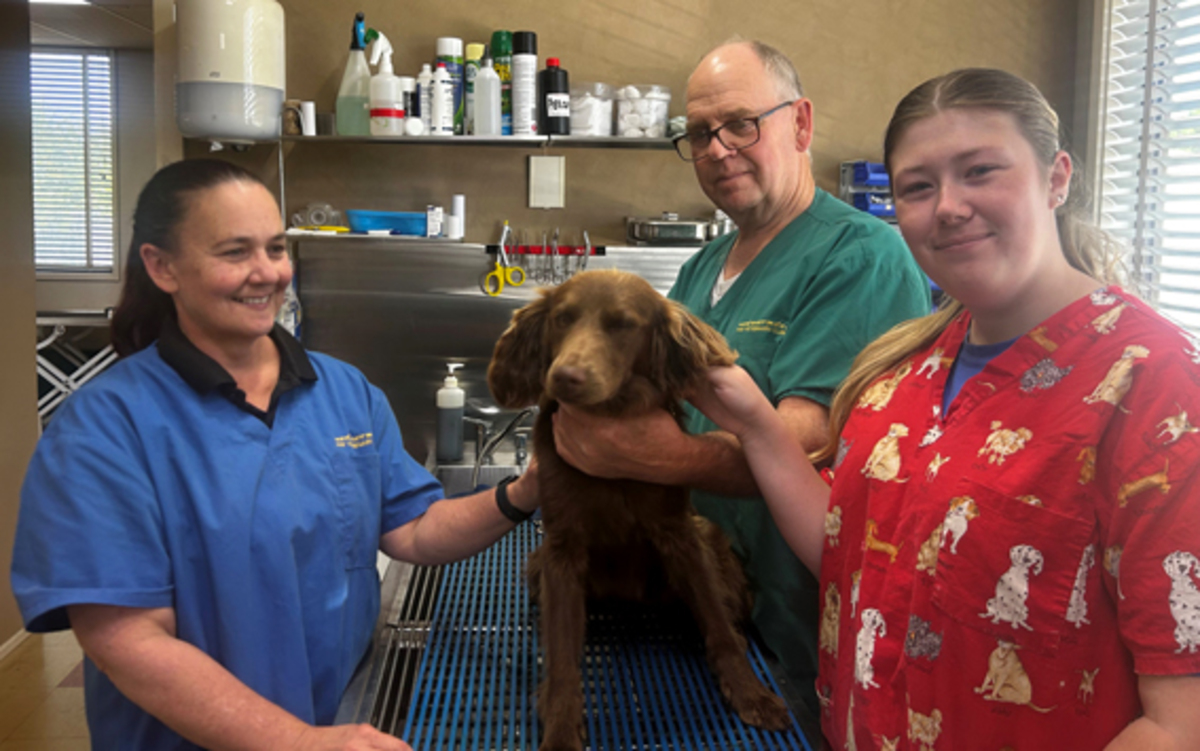Snake season - anti-venom treatments for local pets doubles
Krista Schade
07 November 2024, 4:00 AM
 Hay vet Wayne Gardam (centre) with Susann Carter and Molly Edmonds and a local pet. Molly is completing work experience at the clinic and was on hand when Kimberly Grabham called into capture this photo.
Hay vet Wayne Gardam (centre) with Susann Carter and Molly Edmonds and a local pet. Molly is completing work experience at the clinic and was on hand when Kimberly Grabham called into capture this photo.As the weather warms up the incidents of snake sightings being shared has increased.
Hay Veterinary Clinic’s Wayne Gardam says snake “season” is shaping up to be a particularly bad one for domestic pets, with about twice as many patients as usual being presented to the Hay Veterinary Clinic for treatment for snake bite since September.

Hay vet Wayne Gardam (centre) with Susann Carter and Molly Edmonds and a local pet. Molly is completing work experience at the clinic and was on hand when The Grazier’s Kimberly Grabham called into capture this photo.
The best advice is to act fast. The chances of recovery are as much as 80 per cent greater if your pet or stock is treated early. Animals who are left untreated have a much lower survival rate.
We asked Mr Gardam for his top tips for owners of pets and stock
What to do if my dog (or cat) is bitten by (or seen with) a snake?
1. Don’t Panic. Many pet interactions with snakes don’t result in envenomation.
2. Secure the animal and keep it still. This helps to reduce venom movement into the circulation - you could apply a pressure immobilisation bandage, but it's rare to know which leg was struck.
3. Don’t attempt to kill the snake. This carries a risk of getting bitten yourself (and is illegal).
4. Seek veterinary advice. Ring the vet clinic first. Don’t arrive unexpectedly when they aren’t ready for you, don’t waste time knocking on the door of an unattended clinic after hours.
5. Follow the veterinary advice - folk remedies such as Vitamin C or cutting the ear tip off and swinging the dog around by the tail won’t help, nor will wetting the dog if he is panting.
How can I tell if my dog or stock have been bitten by a snake?
You will hardly ever see puncture wounds, and traces of blood on the dog may be from a snake if the dog has been mauling it.
What might I observe?
The nerve toxin component of snake venom is the main issue with domestic pets - it produces a flaccid muscle weakness progressing to paralysis. In the early stages the dog may be a little wobbly, then not able to support his own weight despite being able to move his legs, then perhaps unable to hold his head up. Sometimes (particularly with cats) the animal will be breathing with their belly heaving as their rib muscles are weak. The pupils of the eyes may be dilated (“glassy eyed”) and not react to light. In time, the animal may become hypothermic, with feet obviously cold to touch.
How long does it take for symptoms to develop?
This is extremely variable, depending on snake species, amount of venom the snake puts out, amount of venom that actually gets into the animal, where it is injected into the animal, size and species of the victim and their subsequent activity.
Onset of symptoms may be as rapid as a few minutes and severe, or take up to 24 hours for mild cases to develop, but will usually be within and hour or two.
Sometimes a rapid-acting fraction of the venom will flatten the dog within minutes, after which there is an apparent recovery and he may appear normal again. If this is seen, it usually indicates a high venom load, and the slower acting venom component will soon take over causing serious symptoms.
How long do we have to commence treatment before it’s too late?
That is also extremely variable for the same reasons as mentioned above. Obviously, the sooner the better once the pet is showing symptoms, and the more rapid the onset of symptoms the more critical the timing becomes.
What can be done to treat an envenomated pet?
The most important aspect of treatment is the careful intravenous administration of antivenom appropriate for the species of snake involved, or appropriate for the snakes known to inhabit the area if this is unknown.
An IV drip is essential to maintain circulation and help prevent kidney damage, as are general nursing care, treatment for hypothermia and symptomatic treatment for any complications that may arise until the patient recovers.
What are the chances of recovery?
This varies with a number of factors, mostly relating to how badly affected the pet is when treatment is started. Unfortunately, some are beyond help despite all efforts, but a recovery rate of 80 percent or more is expected from those that don’t succumb before the antivenom has time to begin to act.
How can I keep my pets safe?
Prevention of snake bite is much easier said than done, but will revolve around minimising the potential for interaction between pets and snakes.
Bear in mind that snakes are free-living wild animals, and are protected native wildlife.
Cats are probably best kept indoors as far as possible, and it would be best to be in the habit of walking dogs on a lead during summer months when around possible snake habitat, and perhaps consider keeping them confined when not supervised in the back yard.
Snake proof fencing or yards will be an engineering challenge – it might be best to think of making an area less attractive for snakes by eliminating overgrown vegetation and potential habitat for the snake, along with access to water.
Keeping poultry food in mouse proof containers and minimising waste of grain around bird cages may help reduce the mouse population and deter snakes coming in to hunt for food.
NEWS
COMMUNITY





